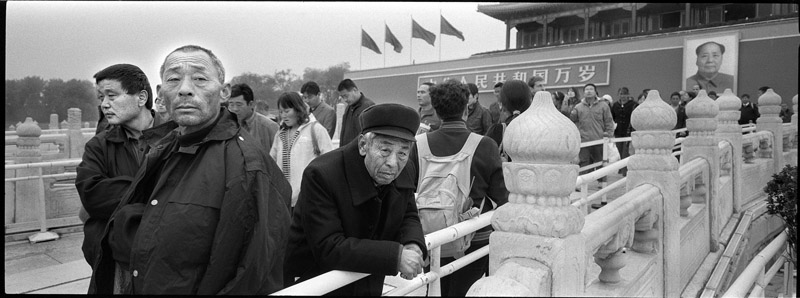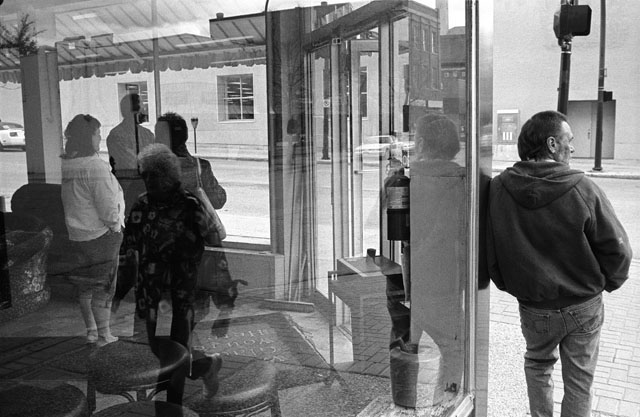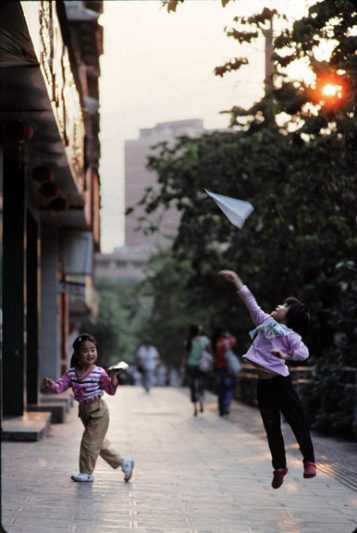1) How did you become a photojournalist?
The short answer is dumb luck. The longer answer is that I grew up always having a visual aptitude. Before I discovered cameras in high school it was drawing or sketching but that always seemed too slow. I’m only half-joking when I say I took up photography because I was too impatient to create a picture by drawing.
I was very lucky to have ended up going to a high school that offered a solid vocational program in photography; around that time, I became really fascinated by the idea of a photojournalist or a newspaper photographer — nothing else could possibly be as interesting as portraying real life, and things that were actually happening.
Those early days gave me the technical ability to understand how to take a picture and it pretty much was a process of learn-by-doing (ie. a million mistakes) over many years that I learned how to make a picture.
One other big stroke of luck was being in Winnipeg at a time when both newspapers had a lot of great photographers on staff. Every day I got to read the paper and see what these familiar names were doing, and that just made me want to do it more. I eventually got to know most of those names and I’m very grateful for what they taught me, mostly by quiet example.
2) You’ve worked quite a while in Brandon, Manitoba. It’s a smaller city and somewhat isolated, so what’s kept you there?
I love being a photographer at a daily newspaper. That fascination with portraying everyday life is still as valid and strong now as it was long ago. I also appreciate stability and security; I think that once basic needs are met and secured, I can then branch out and explore other interests and projects sustainably over a longer term.
There’s been plenty of angst and worry, wondering if I’m missing out on the wider world this way. But in going to conferences and talking to other photographers over the years, it occurred to me that the things they complained and worried about were remarkably similar. I’m not sure there’s any peace in this world, but I do think you can choose to be happy and fulfilled wherever you are. In recent years, I’ve honed my thoughts about the meaning of community and that’s from familiarity — those are two words that inform a lot of what I photograph and why.

3) Like many photographers you have personal projects on the go. One project you’ve been working on for a while is China. What’s the attraction there for you?
It didn’t start out as a project but I guess like the best ones, it evolved into that. I’d probably use the word “exploration” myself. I simply was curious about something and set out to learn about it. I talked to people, read as many books as I could find, devoured all the articles I could about China and Chinese culture. It was a pretty easy subject to be captivated by — an ancient culture undergoing unprecedented change, with unheard-of speed. The recent history alone of China is astounding — epic and tragic on a scale we can’t imagine here.
Just like my education in photography, I found a few happy coincidences soon into my journey. One was an exchange at the university here in my city, where a professor from Nanjing came to teach Mandarin language classes. I signed up, but ironically was interrupted by my first trip to China in late 2002. I had friends there, which helped a lot.
Step by step, over the years, one thing led to another. Since I interpret the world through photography, it was only fitting I’d apply that to experiencing China. I found a subject that I was constantly interested in, and the images I made there are very special to me, even if there was never any particular plan in making them!
I think most photographers are curious about the world. I’m curious about China and so it’s been very rewarding to combine two big passions.
4) You shoot film for the China project. Why?
When I first visited China, we only had film cameras. I’ve shot a little bit of digital over there since, but mostly it’s been film-based. When I go to China, it’s for me…I’ve never been hired or commissioned to go there (but would love that), and I’ve relied on my personal holiday time from my work to do so. I’m not complaining about that — on the contrary I’m grateful to be so lucky to have a job that allows me to pursue this interest.
Film feels tangible to me, it feels substantive. Maybe it’s just psychological but I approach things differently when I use film — perhaps more slowly or methodically. Maybe it’s just nice to have a little extra reminder that I don’t need to rush to meet a deadline. The tools themselves are different (lenses, cameras) and so the image, naturally, looks unique. That’s a big part of it.When I use film, I’m doing something for me, on my time and on my terms. It seems to set things apart, in my mind. I also like crafting an image in black-and-white, with all the rewards that come from manual labour. And, interestingly, it’s not that much extra labour, when you factor in the whole process of digital imaging from start to finish.
I’m no Luddite, I just think the world is a big enough place for both mediums.

5) Sometimes you work with a panoramic camera. What appeals to you about the format?
I’ve worked with a Widelux F7, for a series of images that eventually became an exhiibition of China photographs. I now have an XPan camera — both shoot regular 35mm film. Not every situation ‘feels’ right for this format, but it’s one that seems to suit much of my impressions of China. On a basic level, I feel like there’s so much going on in China that I can’t fit it all into a normal format.
I also really like the idea of breaking out of boundaries normally imposed on photography, even if only in format size. So much is made of new lenses, sensors, and other details of cameras that few people ever realize they’re locked into what manufacturers determine for them. I suppose a person could stitch together separate images digitally, or crop a commonly-proportioned image dramatically, but that’s a pale imitation, I think. A panoramic camera sets out from the start to make a specific kind of image — that’s what I’m interested in, because I think at certain times that’s what’s in front of me.
6) Do you print your own images? What process(es) do you use?
I do ‘wet print’ my own images in the darkroom, although I don’t want to limit myself to that. As I said, I love the craft of making a photograph by hand. I have a lot to learn about that process, but when it’s done right there’s nothing like it. They’re true individuals, each print — especially when you tone the images, as I like to do with selenium and mild sepia. Most of my photographs shot on film are printed this way.
There’s no crime in involving digital processes, to make a hybrid workflow. It depends on each image — there’s no point in retreating to stubborn dogma…whatever works, is what I’m interested in. For those times I scan in images (or for images made on a digital camera) I enlist the help of a few terrific commercial photographers I know here in Brandon, and their printers. I just can’t afford those things right now.
7) Do you have more trips to China planned?
I know I’ll go back sometime, but for now it’s probably best to pay off the bills from the last few times I went there!

8) You’re also shooting images in Brandon that are separate from your newspaper work. Can you tell us about those images?
This is my latest project, and it’s been going on for a little over 2 years now. I live in my city’s downtown, and walk to and from work each day. I got to know the community (there’s that word again) from walking daily and thought I should carry a camera to capture some of the odd things I’d see occasionally.
My favorite focal length is a 35mm lens (in 35mm format) and as cliché as it sounds for street photography I thought black-and-white film felt right. Partly, this was because I could work on it myself on my own time, and partly because of what I mentioned about my China photography — the notion of making it separate and distinct from my day-to-day work.
There was no plan or idea with this project at the outset. I simply did it for the joy and fun of making pictures…I guess it was the photographic equivalent of doodling absentmindedly on a sheet of paper.
Over time, I noticed more and more ‘moments’ and thought I may as well do something with it all. I’m still not totally sure what, exactly, that would be but for now I’m putting them on my blog (www.reservedatalltimes.com) and I think it would be fun and useful to do an exhibition at some future point.
I’ve been inspired a lot by the street photography of Fred Herzog, in Vancouver and especially John Paskievich of Winnipeg with his terrific book “The North End”. I don’t kid myself about coming close to that level of work, but I do like the idea of preserving a community and a time. It seems a lot of photography is, at one level or another, about fighting back against the relentless tide of time erasing everything. Well-crafted and passionate photography can let us hold a moment and examine it later on, and things we’d otherwise forget or even belittle can have a second chance.
On that point, I also remember a scene from Canadian graphic novelist/cartoonist Seth’s book “It’s a Good Life If You Don’t Weaken”. He had a “walk in the snow” moment where he realized his love of abandoned, decaying old buildings was tied to his lamenting the passing of time. I’m not sure if I’m quite that nostalgic, but I think that urge is behind a lot of this type of photography.
9) Are there any other projects you’re working on?
I’m on the Visual Arts committee of our local Folk Music and Arts Society, and each year we do a portrait project. It ties in nicely with my feelings about the importance of community and how the arts can help foster that. So, there’s something new each year with that.
I’d like to pursue arts grants in the future, although I’ve learned enough in my initial research to see that it’s almost a full time job applying and following up on various grants. It’s definitely not “free money” as some uninformed people might think!
Down the road, I’d like to renew an interest in wetplate collodion photography. I love the idea of an extinct process existing in the 21st century, but I’m really fascinated by its uses for portraiture as photography is a way I reach out to others.

10) Your website is currently just a cover page, will we be able to see a full website soon?
Yes, but I’m run a bit off my feet with work and other photography now. And mostly, I’m running short of funds too! I’m working with a colleague at my paper to get a site up, but my desire is that it’s visually well crafted and stand out to a graphic designer. I’d like any site I have to really be strong from a design perspective, as well as being a clear representation of my photography.
My goal is to have my site up and running early in the New Year.
BLOG – www.reservedatalltimes.com
SITE – www.colincorneau.com
